
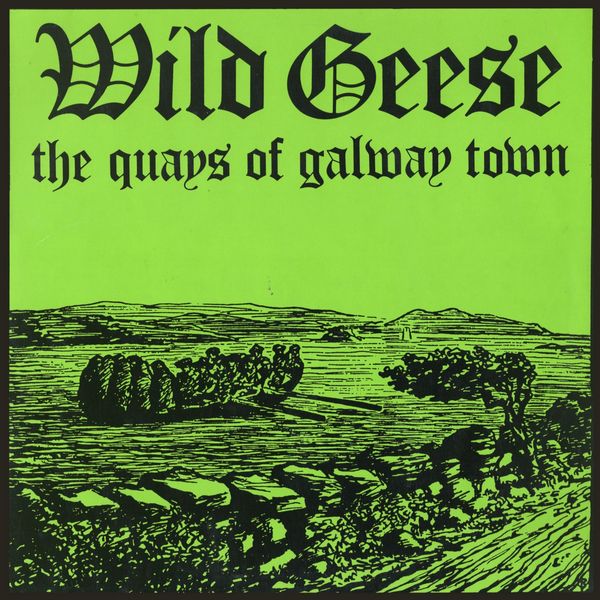 |
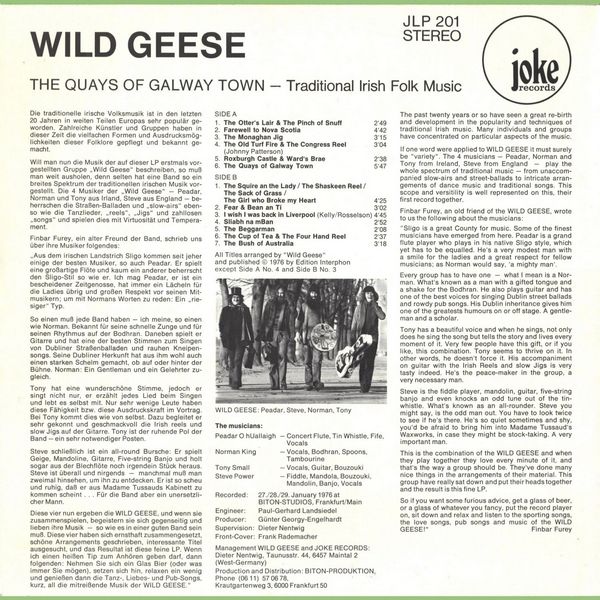
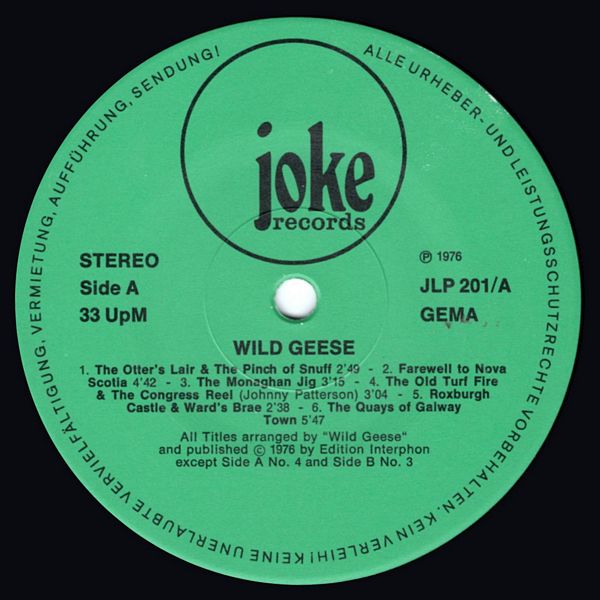
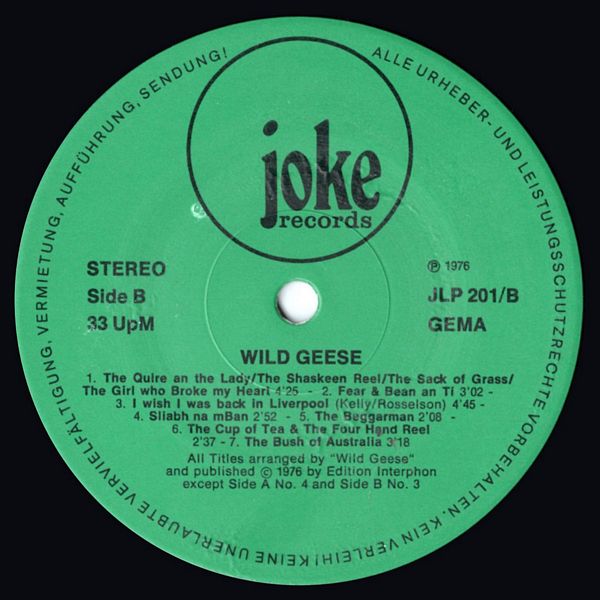 |
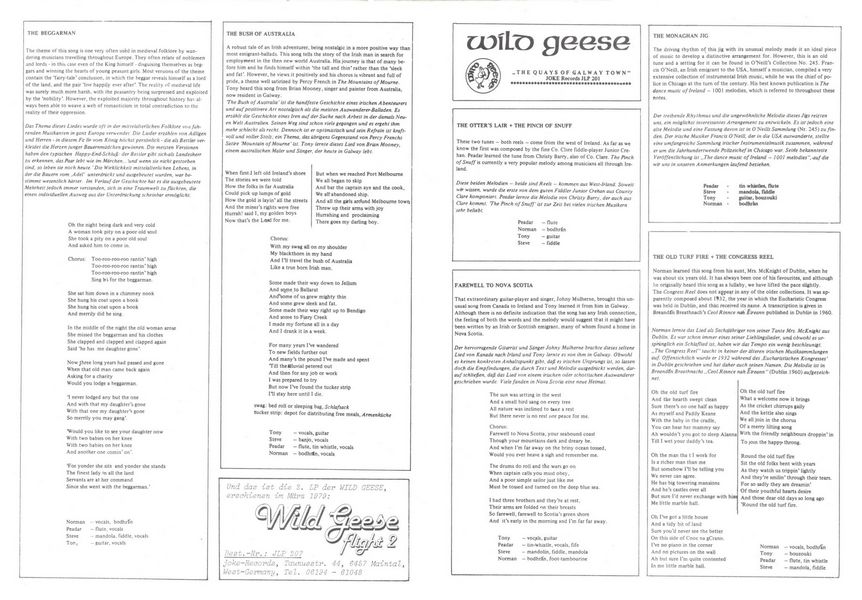
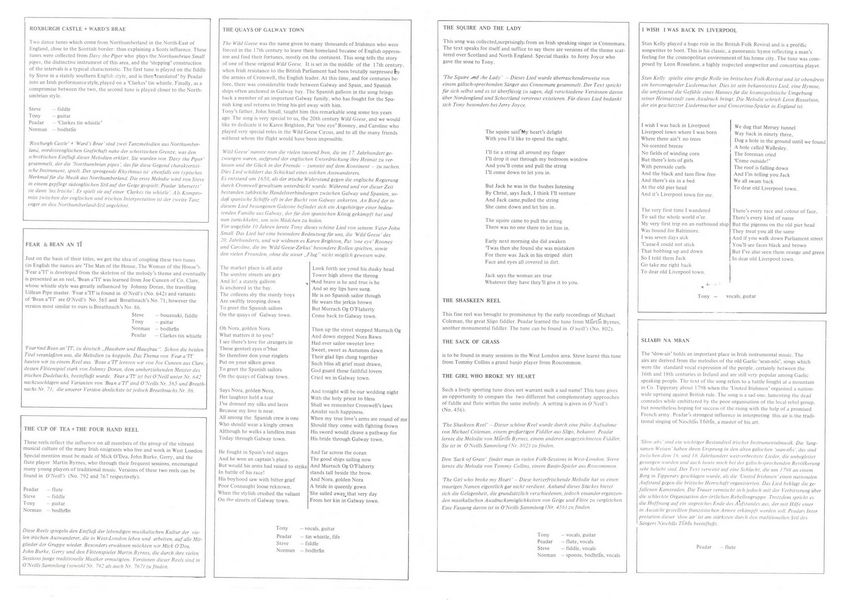
|
Sleeve Notes
The past twenty years or so have seen a great re-birth and development in the popularity and techniques of traditional Irish music. Many individuals and groups have concentrated on particular aspects of the music.
If one word were applied to WILD GEESE it must surely be "variety". The 4 musicians — Peadar, Norman and Tony from Ireland, Steve from England — play the whole spectrum of traditional music — from unaccompanied slow-airs and street-ballads to intricate arrangements of dance music and traditional songs. This scope and versatility is well represented on this, their first record together. Finbar Furey, an old friend of the WILD GEESE, wrote to us the following about the musicians: "Sligo is a great County for music. Some of the finest musicians have emerged from here. Peadar is a grand flute player who plays in his native Sligo style, which yet has to be equalled. He's a very modest man with a smile for the ladies and a great respect for fellow musicians; as Norman would say, 'a mighty man'. Every group has to have one — what I mean is a Norman. What's known as a man with a gifted tongue and a shake for the Bodhrán. He also plays guitar and has one of the best voices for singing Dublin street ballads and rowdy pub songs. His Dublin inheritance gives him one of the greatest humours on or off stage. A gentleman and a scholar.
Tony has a beautiful voice and when he sings, not only does he sing the song but tells the story and lives every moment of it. Very few people have this gift, or if you like, this combination. Tony seems to thrive on it. In other words, he doesn't force it. His accompaniment on guitar with the Irish Reels and slow Jigs is very tasty indeed. He's the peace-maker in the group, a very necessary man.
Steve is the fiddle player, mandolin, guitar, five-string banjo and even knocks an odd tune out of the tin-whistle. What's known as an all-rounder. Steve you might say, is the odd man out. You have to look twice to see if he's there. He's so quiet sometimes and shy, you'd be afraid to bring him into Madame Tussaud's Waxworks, in case they might be stock-taking. A very important man.
This the combination of the WILD GEESE and when they play together they love every minute of it, and that's the way a group should be. They've done many nice things in the arrangements of their material. This group have really sat down and put their heads together and the result is this fine LP.
So if you want some furious advice, get a glass of beer, or a glass of whatever you fancy, put the record player on, sit down and relax and listen to the sporting songs, the love songs, pub songs and music of the WILD GEESE!"
Finbar Furey
THE OTTER'S LAIR & THE PINCH OF SNUFF — These two tunes — both reels — come from the west of Ireland. As far as we know the first was composed by the fine Co. Clare fiddle-player Junior Crehan. Peadar learned the tune from Christy Barry, also of Co. Clare. The Pinch of Snuff is currently a very popular melody among musicians all through Ireland.
FAREWELL TO NOVA SCOTIA — That extraordinary guitar-player and singer, Johny Mulherne, brought this unusual song from Canada to Ireland and Tony learned it from him in Galway. Although there is no definite indication that the song has any Irish connection, the feeling of both the words and the melody would suggest that it might have been written by an Irish or Scottish emigrant, many of whom found a home in Nova Scotia.
THE MONAGHAN JIG — The driving rhythm of this jig with its unusual melody made it an ideal piece of music to develop a distinctive arrangement for. However, this an old tune and a setting for it can be found in O'Neill's Collection No. 245. Francis O'Neill, an Irish emigrant to the USA, himself a musician, compiled a very extensive collection of instrumental Irish music, while he was the chief of police in Chicago at the turn of the century. His best known publication is The dance music of Ireland - 1001 melodies, which is referred to throughout these notes.
THE OLD TURF FIRE & THE CONGRESS REEL — Norman learned this song from his aunt, Mrs. McKnight of Dublin, when he was about six years old. It has always been one of his favourites, and although he originally heard this song as a lullaby, we have lifted the pace slightly. The Congress Reel does not appear in any of the older collections. It was apparently composed about 1932, the year in which the Eucharistic Congress was held in Dublin, and thus received its name. A transcription is given in Breandán Breathnach's Ceol Rinnce nah Éireann published in Dublin in 1960.
ROXBURGH CASTLE & WARD'S BRAE — Two dance tunes which come from Northumberland in the North-East of England, close to the Scottish border: thus explaining a Scots influence. These tunes were collected from Davy the Piper who plays the Northumbrian Small pipes, the distinctive instrument of this area, and the 'stepping' construction of the intervals is a typical characteristic. The first tune is played on the fiddle by Steve in a stately southern English style, and is then 'translated' by Peadar into an Irish performance style, played on a 'Clarkes' tin whistle. Finally, as a compromise between the two, the second tune is played closer to the Northumbrian style.
FEAR & BEAN AN Tí — Just on the basis of their titles, we got the idea of coupling these two tunes (in English the names are 'The Man of the House, The Woman of the House'). 'Fear a'Tí' is developed from the skeleton of the melody's theme and eventually is presented as an reel, 'Bean a'Tí' was learned from Joe Cuneen of Co. Clare, whose whistle style was greatly influenced by Johnny Doran, the travelling Uillean Pipe master. 'Fear a'Tí' is found in O'Neill's (No. 642) and variants of 'Bean a'Tí' are O'Neill's No. 565 and Breathnach's No. 71; however the version most similar to ours is Breathnach's No. 86.
THE CUP OF TEA & THE FOUR HAND REEL — These reels reflect the influence on all members of the group of the vibrant musical culture of the many Irish emigrants who live and work in West London Special mention must be made of Mick O'Dea, John Burke, Gerry, and the flute player Martin Byrnes, who through their frequent sessions, encouraged many young players of traditional music. Versions of these two reels can be found in O'Neill's (No. 792 and 767 respectively).
THE QUAYS OF GALWAY TOWN — The Wild Geese was the name given to many thousands of Irishmen who were forced in the 17th century to leave their homeland because of English oppression and find their fortunes, mostly on the continent. This song tells the story of one of these original Wild Geese. It is set in the middle of the 17th century, when Irish resistance to the British Parliament had been brutally surpressed by the armies of Cromwell, the English leader. At this time, and for centuries before, there was considerable trade between Galway and Spain, and Spanish ships often anchored in Galway bay. The Spanish galleon in the song brings back a member of an important Galway family, who has fought for the Spanish king and returns to bring his girl away with him. Tony's father, John Small, taught him this remarkable song some ten years ago. The song is very special to us, the 20th century Wild Geese, and we would like to dedicate it to Karen Brighton, Pat 'one eye' Rooney, and Caroline who played very special roles in the Wild Geese Circus, and to all the many friends without whom the flight would have been impossible.
THE SQUIRE AND THE LADY — This song was collected, surprisingly, from an Irish speaking singer in Connemara. The text speaks for itself and suffice to say there are versions of the theme scattered over Scotland and North England. Special thanks to Jerry Joyce who gave the song to Tony
THE SHASKEEN REEL — This fine reel was brought to prominence by the early recordings of Michael Coleman, the great Sligo fiddler. Peadar learned the tune from Máirtín Byrnes, another monumental fiddler. The tune can be found in O'Neill's (No. 802).
THE SACK OF GRASS — is to be found in many sessions in the West London area. Steve learnt this tune from Tommy Collins a grand banjo player from Roscommon.
THE GIRL WHO BROKE MY HEART — Such a lively sporting tune does not warrant such a sad name! This tune gives an opportunity to compare the two different but complementary approaches of fiddle and flute within the same melody. A setting is given in O'Neill's (No. 456).
I WISH I WAS BACK IN LIVERPOOL — Stan Kelly played a huge role in the British Folk Revival and is a prolific songwriter to boot. This his classic, a panoramic hymn reflecting a man's feeling for the cosmopolitan environment of his home city. The tune was composed by Leon Rosselson. a highly respected songwriter and concertina player.
SLIABH NA MBAN — The 'slow-air' holds an important place in Irish instrumental music. The airs are derived from the melodies of the old Gaelic 'Sean-nós', songs which were the standard vocal expression of the people, certainly between the 16th and 18th centuries in Ireland and are still very popular among Gaelic speaking people. The text of the song refers to a battle fought at a mountain in Co. Tipperary about 1798 when the 'United Irishmen' organised a nationwide uprising against British rule. The song is a sad one, lamenting the dead comrades while embittered by the poor organisation of the local rebel group, but nonetheless hoping for success of the rising with the help of a promised French army. Peadar's strongest influence in interpreting this air is the traditional singing of Niochlás Tóibín, a master of his art.
THE BEGGARMAN — The theme of this song is one very often used in medieval folklore by wandering musicians travelling throughout Europe. They often relate of noblemen and lords - in this case even of the King himself - disguising themselves as beggars and winning the hearts of young peasant girls. Most versions of the theme contain the 'fairy-tale' conclusion, in which the beggar reveals himself as a lord of the land, and the pair 'live happily ever after' The reality of medieval life was surely much more harsh, with the peasantry being surpressed and exploited by the 'nobility'. However, the exploited majority throughout history has always been able to weave a web of romanticism in total contradiction to the reality of their oppression.
THE BUSH OF AUSTRALIA — A robust tale of an Irish adventurer, being nostalgic in a more positive way than most emigrant-ballads. This song tells the story of the Irish man in search for employment in the then new world Australia. His journey is that of many before him and he finds himself within 'the tall and thin' rather than the 'sleek and fat'. However, he views it positively and his chorus is vibrant and full of pride, a theme well satirized by Percy French in The Mountains of Mourne. Tony heard this song from Brian Mooney, singer and painter from Australia, now resident in Galway.